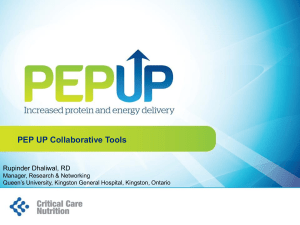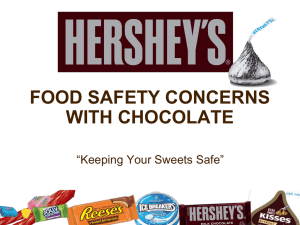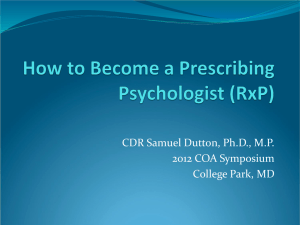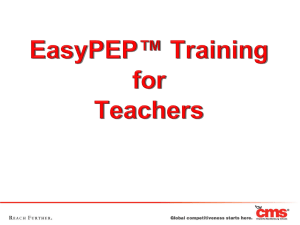PPT - National STD/AIDS Control Programme
advertisement
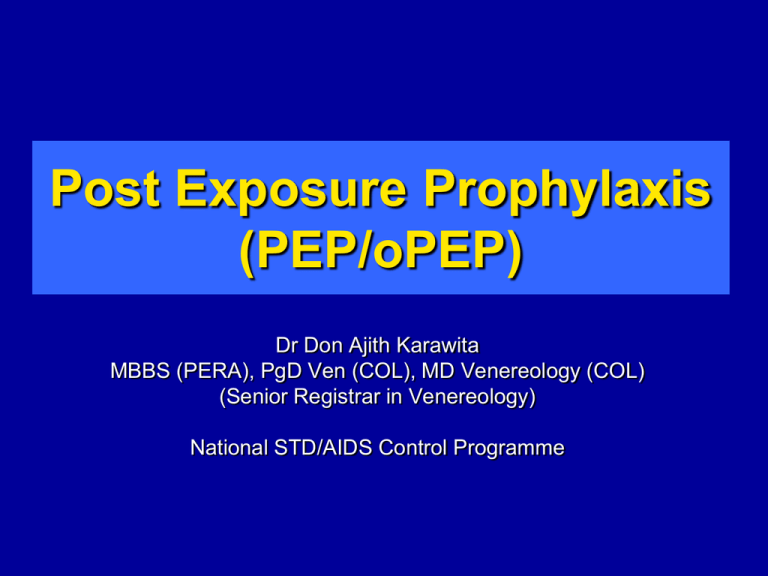
Post Exposure Prophylaxis (PEP/oPEP) Dr Don Ajith Karawita MBBS (PERA), PgD Ven (COL), MD Venereology (COL) (Senior Registrar in Venereology) National STD/AIDS Control Programme CDC Guidelines 2001. CDC headquarters in Atlanta Standard Precautions 1. Hand washing 7. Occupational health and blood borne pathogens 2. Gloves – Handling of sharps 3. Personal protective – Prevention of mucous equipment (PPE) membrane exposures 4. Patient care equipments – Management of needle – Cleaning of instruments 5. Environmental control – Management of spills 6. Linen management stick accident or mucous membrane exposure – Collection and transport of specimens 8. Patient isolation Additional Precautions 1. Transmission based precautions – – – Airborne precautions (droplet nuclei < 5µm) Droplet precautions (droplet nuclei > 5µm) Contact precautions / isolation 2. Strict isolation 3. Aseptic precautions • • Cleaning of entry site of the body Hands of the staff must be disinfected and gloved. Choice of method RISK GROUP High risk (Critical) Direct contact with a break in skin or mucous membrane or entering a sterile body area. Intermediate risk (Semi-critical) Direct contact with mucous membranes or non-intact skin EXAMPLES CHOICE OF PROCESSING Surgical instruments, Needles, Syringes, cystoscopes, Laparoscopes, Surgical dressings. Must be sterile Heat sterilization (autoclaving), chemical sterilants Endoreacheal tubes, Gastroscopes & other endoscopes. High level disinfection acceptable, liquid chemicals. Low risk (Non-critical) Stethoscopes, BP Low level disinfection Items in contact with intact apparatus, bed pans, urinals skin. or through cleaning with detergent acceptable Disinfectant / Antiseptic • Alcohol – Surgical spirit (60% isopropyl alcohol) – 70% ethyl alcohol – Alcohol hand rub (Isopropyl alcohol with glycerol) • Aldehydes – Cidex (2% glutaraldehyde solution) • Chlorhexidines – Hibisol (0.5% chlorhexidine in 70% alcohol – Hibitane (4% chlorhexidine gluconate – Hibiscrub (4% chlorhexidine gluconate with a detergent) Disinfectant / Antiseptic • Chlorine releasing agents – TCL, Bleaching powder (Calcium hypochiorite 35% w/w of available chlorine) – Sodium hypochlorite liquid form • • • • 5% stock solution 1% (10,000ppm) 0.1%(1000ppm) 0.01% (125ppm) Milton • Iodophors – Betadine, Wokadine (10% solution, available iodine 1%) – Betadine scrub, Wokadine scrub (7.5% Povidone iodine scrub, avilable iodine 0.75% • Peracetic acid – Perasafe (Peracetic acid) • Phenolic disinfectants – Lysol (2%, 5% solutions) Hospital waste Hazardous waste 1. Sharps General or Nonhazardous waste 1. Infectious waste (incinaration/ Burial) 2. Pathologicl waste (incinaration/ Burial) Dispose to common garbage site/bin 3. Chemical waste (Returned to supplier/ MSD) 4. Pharmaceutical waste (Returned to supplier/ MSD) 5. Radioactive waste (Keep for radioactive decay→Dispose as non hazardous waste) Collected by local authorities Hepatitis B Virus (HBV), Hepatitis C Virus (HCV), and Human Immunodeficiency Virus (HIV) • • • • Bloodborne viruses Can produce chronic infection Transmissible in healthcare settings Data from multiple sources (e.g., surveillance, observational studies, serosurveys) used to assess risk of occupational transmission Risk of Bloodborne Virus Transmission after Occupational Percutaneous Exposure Source Risk HBV HBeAg + HBeAg - 22.0-30.0% 1.0-6.0% HCV 1.8% HIV 0.3% Evaluation - Occupational exposure to infectious materials Patient Percutaneous Severe, Less severe 1.Exposure Mucous membrane/Non intact skin 3. Determine Infectious Status of Source 2. Exposure Substance Blood, Bloody fluid, OPIM Small volume, Large volume. Health care worker 4. Determine Susceptibility of (HCW) Exposed Person Elements of Postexposure Management • Wound management & Exposure reporting → Step 1 • Risk Assessment → Step 2 – (1) blood borne infection status of source person – (2) Infectious material – (3) type and severity of exposure – (4) Susceptibility of HCW • Appropriate treatment → Step 3 • Follow-up, and counseling → Step 4 Step 1 Provide immediate care to the exposure site • Post exposure Wound Management: – Wash wounds and skin with soap and water – Flush mucous membranes with water – No evidence of benefit for: • application of antiseptics or disinfectants • squeezing (“milking”) puncture sites • Avoid use of bleach and other agents caustic to skin • Inform authorities → Infection control unit. Management of sharps accidents WHO / SEAR 1999 WHO / SEAR 1999 Elements of Postexposure Management • Wound management & Exposure reporting → Step 1 • Risk Assessment → Step 2 – (1) blood borne infection status of source person – (2) Infectious material – (3) type and severity of exposure – (4) Susceptibility of HCW • Appropriate treatment → Step 3 • Follow-up, and counseling → Step 4 Postexposure Management: Risk Assessment (Seek expert advice) Infectious status of the source person (SC) – presence of HBsAg – presence of HCV antibody – presence of HIV antibody – if source unknown, assess epidemiologic and clinical evidence (Do not test discarded needles) Body substance – blood – bloody fluid – Other potentially infectious materials (OPIM) (semen, vaginal secretions and CSF, synovial, pleural, peritoneal, pericardial and amniotic fluids) or tissue Type of exposure (EC) – – – – percutaneous mucous membrane non-intact skin bites resulting in blood exposure Determine susceptibility of exposed person (HCW) – Hepatitis B vaccine status – HBV immune status if vaccine response status in unknown – Anti-HCV and ALT – HIV antibody Elements of Postexposure Management • Wound management & Exposure reporting → Step 1 • Risk Assessment → Step 2 – (1) blood borne infection status of source person – (2) Infectious material – (3) type and severity of exposure – (4) Susceptibility of HCW • Appropriate treatment → Step 3 • Follow-up, and counseling → Step 4 Step 3 Give PEP for exposures posing risk of infection transmission • HBV – Give oPEP as soon as possible within 24 hours. – PEP can be given to pregnant women • HCV – PEP not recommended • HIV – Initiate PEP within hours of exposure (2-72 Hours) – Offer pregnancy testing to all women of child bearing age not known to be pregnant. – Seek expert consultation if viral resistance suspected. – Administer PEP for 4 weeks if tolerated. oPEP Hepatitis B Infection Concentration of HBV in Body Fluids High Moderate Low/Not Detectable Blood Serum Wound exudates Semen Vaginal Fluid Saliva Urine Feces Sweat Tears Breast Milk Vaccination and antibody response status of exposed worker* Unvaccinated Treatment when source is found to be: HBsAg positive HBsAg negative Source unknown or not available for testing HBIG x1 and initiate Hepatitis B vaccine series. Initiate hepatitis B vaccine series Initiate hepatitis B vaccine series Known responder No treatment No treat. No treatment Known nonresponder HBIGx1 and initiate revaccination or HBIGx2 No treatment If known high risk source, treat as if source were HBsAg positive Antibody response unknown Test exposed person for No anti-HBs treatment 1. If adequate, no treatment. 2. If inadequate, HBIGx1 and vaccine booster. Test exposed person for anti-HBs: 1. If adequate, no Treatment 2. If inadequate, vaccine booster and recheck titer in 1-2 months. Previously vaccinated • Persons who have previously been infected with HBV are immune to reinfection and do not require PEP. • Hepatitis B immunoglobulin: dose 0.06ml/kg im • A responder is a person with adequate levels of serum antibody to HBsAg (i.e. anti-HBs > 10mIU/ml): a nonresponder is a person with inadequate response to vaccination (i.e. serum anti-HBs antibody< 10mIU/ml) • The option of giving one dose of HBIG and reinitiating the vaccine series is preferred for non-responders who have not completed a second 3-dose vaccine series. For those who previously completed a second vaccine series but failed to respond, 2doses of HBIG are preferred. Give one dose at time of exposure, and the second dose one month later. Efficacy of HBV PEP* Regimen Prevention of HBV Infection Multiple doses of HBIG alone when 1st dose initiated within 1 week 70-75% Hepatitis B vaccine series alone 70-75% Combination of HBIG and vaccine series 85-95% * Estimated for adults, based on perinatal data Hepatitis B Vaccine: Long-Term Efficacy • Anti-HBs titers decline to <10 mIU/mL in 3050% of adults within 8-10 years after vaccination • Exposure to HBV results in anamnestic antiHBs response that prevents clinically significant HBV infection • Immune memory remains intact for at least 20 years after immunization • Chronic HBV infection rarely documented among vaccine responders • Booster doses currently not recommended oPEP Hepatitis C Infection oPEP Hepatitis C Infection Not recommended oPEP HIV Infection Overview of the HIV clinical disease AIDS HIV Seroconversion illness Clinical stage 4 33% Clinical stage 2 75% Clinical stage 1 1-4wks 3wks 8 to 12 years Clinical stage 3 AIDS Defining illnesses Natural History of HIV Infection Percutaneous injuries Infection status of the source HIV-positive, class 1 Aymptomatic HIV infection or known low viral load (e.g. <1500) HIV-positive, class 2 Symptomatic HIV infection, AIDS, Acute seroconversion, or known high viral load Source of unknown HIV status (e.g deceased source person with no samples available for HIV testing) Unknown source (e.g. a needle from a sharps disposal container) HIV negat ive Less severe (e.g. solid needle, superficial injury) Recommend basic 2-drug PEP Recommend expanded 3-drug PEP. Generally, no PEP Generally, no PEP No PEP More severe (e.g. large-bore hollow needle, deep puncture, visible blood on device or needle used in patient’s artery or vein) Recommend expanded 3drug PEP. Recommend expanded 3-drug PEP. Generally, no PEP Generally, no PEP No PEP Exposure type Mucous membrane exposures and non-intact skin exposures. Infection status of the source HIV-positive, class 1 Asymptomat ic HIV infection or known low viral load (e.g. <1500) HIV-positive, class 2 Symptomatic HIV infection, AIDS, acute seroconversion , or known high viral load Source of unknown HIV status (e.g. deceased source person with no samples available for HIV testing) Unknown HIVsource Negativ (e.g. splash e from inappropriat ely disposed blood) Small volume (e.g. few drops) Consider basic 2-drug PEP Recommend basic 2-drug PEP Generally, No PEP Generally, No PEP No PEP Large volume (e.g. major blood splash) Recommend Recommend basic 2-drug expanded 3PEP drug PEP Generally, No PEP Generally, No PEP No PEP Exposure type • If drug resistance is a concern, obtain expert consultation. Initiation of PEP should not be delayed pending expert consultation and, because expert consultation alone cannot substitute for face-to-face counseling, resource should be available to provide immediate evaluation and follow-up care for all exposures. • The designation “consider PEP” indicates that PEP is optional and should be based on as individualized decision between the exposed person and the treating clinician. However, consider basic 2-drug PEP for a source with HIV risk factors, or occurs in a setting where exposure to HIV-infected persons is likely. • If PEP is offered and taken, and the source is later determined to be HIV negative, PEP should be discontinued. • For skin exposures, follow-up is indicated only if there is evidence of compromised skin integrity (e.g. dermatitis, abrasion, or open wound) Considerations When Using PEP Risk of Transmission PEP Risk of Adverse Effects Postexposure Management: HIV PEP Basic Regimen Basic Regimen Zidovudine (ZDV) Lamivudine (3TC) 200 mg tid (300 mg PO bid) 150 mg bid Alternate Basic Regimens Didanosine (ddI) Stavudine (d4T) 200 mg bid (125 mg bid if <60 kg) 40 mg bid (30 mg bid if <60 kg) Stavudine (d4T) Lamivudine (3TC) 40 mg bid (30 mg bid if <60 kg) 150 mg bid Postexposure Management: HIV Expanded Regimen Expanded Regimen Basic regimen plus one of the following Indinavir (IDV) 800 mg q8h Nelfinavir (NFV) 750 mg tid or 1250 mg bid Efavirenz (EFV) 600 mg daily Abacavir (ABC) 300 mg bid Elements of Postexposure Management • Wound management & Exposure reporting → Step 1 • Risk Assessment → Step 2 – (1) blood borne infection status of source person – (2) Infectious material – (3) type and severity of exposure – (4) Susceptibility of HCW • Appropriate treatment → Step 3 • Follow-up, and counseling → Step 4 Step 4 Perform follow up testing and provide counseling HBV Infection HCV infection HIV Infection Advice exposed persons to seek medical evaluation for any acute illness occurring during follow-up Advice exposed persons to seek medical evaluation for any acute illness occurring during follow-up Perform HIV antibody testing for illness compatible with an acute retroviral syndrome. Test for anti-HBs 1-2 months after last dose of vaccine if only vaccine given. (anti-HBs response to vaccine Perform testing for antiHCV and ALT 4-6 months after exposure cannot be ascertained if HBIG received in the previous 3-4 months) Evaluate exposed persons taking PEP within 72 hours after exposure and monitor for drug toxicity for at least 2 weeks. Follow-up not indicated if exposed Perform HCV RNA person immune to HBV or received testing at 4-6 weeks if HBIG PEP earlier diagnosis of HCV infection desired Perform HIV-antibody testing for at least 6 months postexposure (e.g. at baseline, 6 weeks, 3 months, and 6 months) Prevent secondary transmission on during the follow-up period. Refrain from donating blood, plasma, organs, tissue, or semen. No need for: modification of sexual practices or patient care, refraining from conception Prevent secondary transmission on during the follow-up period. Confirm repeatedly reactive anti-HCV EIA with supplemental test Preventing Transmission of Blood borne Viruses in Healthcare Settings Frequency of Percutaneous Injury in Healthcare Personnel • Based on CDC estimates, 384,325 (95% CI 311,091-463,922) percutaneous injuries are sustained by healthcare personnel in US hospitals annually* • The number of injuries sustained outside of hospital settings is unknown • Frequency of percutaneous injury varies by occupational group and healthcare setting * Panlilio, AL, et. al. Estimate of the Annual Number of Percutaneous Injuries in U.S. Healthcare Workers. 4th Decennial Conference, March 5-9, 2000 Preventing Transmission of Bloodborne Viruses in Healthcare Settings • Promote hepatitis B vaccination • Treat all patients as potentially infectious • Use barriers to prevent blood/body fluid contact • Prevent percutaneous injuries

